You relocated to Cairo a year ago. Could you tell me what prompted you to move there? How has your first year been? How long do you intend to stay?
I moved to Cairo in January 2012, just before the first anniversary of the revolution, as I had an offer of a full time teaching post at the American University in Cairo (AUC). I saw the job application by chance in an artists’ newsletter a year earlier in the UK. I applied for post, then the revolution happened in January 2011 and I presumed that would be the last I would hear of my application. However after months I had a video job interview and was offered the position. I went to Cairo in 2011 to check out the institution and see what the city was like on a street level. I found it to be an immense mess but was attracted to its disheveled elegance and the character of the people I met.
The year I have spent here has unfurled a lot of unexpected experiences and it is a city that always offers new encounters. Obviously the political turmoil impacts on your life and can prohibit the everyday but outside of the heightened moments of street violence life here is pretty relaxed. The central area around Tahrir Sq, known as Downtown, is like a European city with amazing 19th and early 20th century architecture, all covered in a patina of sand and dirt along with a fair amount of neglect. My post is for 3 years so I will be here until then however you never really know what will happen and learning to not plan is one aspect I like of life in Cairo.
You have blogged about your time in Cairo. What purpose did writing this blog serve for you? How is the political situation in Egypt at the moment?
How do you see it unfolding in the near future? What is happening on the artscene?
http://ronnieclose.wordpress.com/
I started the blog for pragmatic personal reasons, namely as a way to keep in touch with people or at least let them have a sense of what I was doing here. Also moving to a place in the midst of radical political change with such enormous cultural differences tends to impact on the self and the blog helped mediate experiences and impressions. However it is not intended as a portal of what is happening in Egypt and there are many blogs already doing that. Mine was purely personal, almost an email time saver and a personal record of my first year in Cairo.
The current political situation is at a very formative stage for the future of Egypt. From my perspective the society is polarised between Islamic traditional groups and more leftist secular organisations. Most people are somewhere in between and trying to figure out what the momentum of 2011 revolution should be, what sort of a society they want. Given these tensions the discourse is generally civilised and tolerant. The on-going role of the military and remnants of the old regime, plus other forces, seem intent on undermining open political progress. In addition the everyday economic pressures impact of the broad populace and living conditions have worsened since I got here.
I have abandoned trying to predict patterns or directions in the future. I remember when I heard about the Port Said football massacre last year. I had just spent the day with friends visiting a pipe-making factory where a friend of mine worked. It was a weird day spent in this industrial factory on the outskirts of Cairo and then later in the car on the way back I heard that 20 then 30 then 40 and so on people had died. No one could have predicted such an incident and the ramifications are immense in Egypt. The formation of opposition movements to the Muslim Brotherhood is a positive development and offers an alternative to the MB vision. I think it is going to take a few years for the idea of difference to be absorbed into the body politic, which is understandable given the years of authoritarian rule. In the short term much could be improved by investigating murders by the security forces over the last 2 years and implementing real social and economic change.
The artscene here is small given the scale of the city, around 18 million, and there are separate artscenes that don’t interact. There is a state funded and commercial scene that is regressive and more or less immune to international contemporary artwork. There are a few small institutions scattered around the city that are familiar with contemporary art and get a lot of support from Egyptians and international artists. But in comparison to Beirut or Istanbul this city wouldn’t have such a developed professionalised artscene. However there is a strong community of artists but there are few funding opportunities or large-scale events to encourage or promote artists and impact on the broader society. For me the subterranean character of the contemporary artscene is a quality and sort of relief. The absence of a Cairo art publication is an indication of the grassroots nature of the scene with little critical writing available on art in Egypt.
What projects have you been working on in Egypt? I am particularly interested to hear about your work with the Ultras, a non-sectarian and classless organisation of football fans, whose political activities made them famous in the 2011 Tahrir Square street battles where many fans were killed or injured. Could you tell me about this group and how you came to work with them? What challenges have you faced as an ‘outsider’ with a camera? I understand you have received funding from the Irish Film Board which has allowed you to develop your project?
I met some Ultras in 2011 and was struck by their street politics, which is different from the perception of most football fans. I went to one of their demonstrations and was absorbed by their chorographic displays, or Tifos as they are called. I arranged to meet a group through a contact and began to establish a relationship. At the same time I began filming street riots and protests that exploded in the aftermath of Port Said. In March 2012 the Ultras set up a protest camp beside the parliament and this became my main focus for a few months. I never experienced any impediments in filming and the Ultras form of display is incredibly animated but not aggressive. Challenges came about through the language barrier and my inability to understand a lot of the chants and other materials I’d come across. In my work I try to engage these issues and feel they are important to acknowledge. The Ultras have an antagonistic relationship to the media and I think as a foreigner I was perceived as a less of a threat and was trusted more easily. The work I am making with the Ultras has a number of outcomes and one potential is a feature length documentary film. I got some development funding from the Irish Film Board and a production company is fundraising for the film. This would be appropriate to the subject but in addition I am developing less narrative based video and photographic works. The Ultras have shared some of their own video material and I am particularly interested in how this can play off the material I gather.
http://www.ronnieclose.com/Project%20ULTRA.html
Do you feel a sense of continuum between your current project in Cairo and previous works you have made in Northern Ireland which looked at the Hunger Strikes? Could you tell me about your research and working process?
A relationship between the two projects could be read through the representation of political movements in film and photography works that is a politics of aesthetics. Of course they are separated by culture and history but share some commonalties of political activistism. The architecture and visual landscape of Cairo has been transformed by a huge military presence in the city. The construction of concrete walls around the Ministry of Interior has blocked off much of the Downtown area and barbed wire manned by troops does resonate with images of the Northern Ireland in the 1970s. For me though they are very different movements as Republicanism was formed from traditions and was a very hierarchical organistation with clear objectives. The Ultras have no overt political aims or manifesto. These elements are what make them unique in Egyptian society and threatening to hegemony. These characteristics created their rapid expansion and popularity in contemporary Egypt and they are a new entity in a fast changing country. Such beliefs and motivations of theses groups are part of my interest and I am drawn to know more about how such organisations mobilise.
My working practice involves researching these social groups and getting to know them through interviews and photographic representation. This opens up a dialogue between ideas of appearance and reality and the slippery or unreliable nature of these terms. Through exhibition installation of video or photographic based works I look at ways to use space to open up a discourse. In the work I made on the Hunger Strikes I placed interviews with ex-prisoners who had been on strike in 1981 with a cinematic silent film I scripted. The film, Night-Time Room, followed a fictional Republican character who was a symbiosis of the interviewees and allowed me to probe areas that they would not allow me to record, that were off their script. It also drew on experiences and conversations I had with them in their homes. To me their existence was a montage of the quotidian with trauma in what was becoming an elapsed history.
The Ultras project is very different in the sense that my own presence raises a number of complex questions of representation. However what drew me to the group was a fascination with the aesthetic displays and their social organisation, in particular in a society like Egypt with rigid hierarchical structures shape most peoples’ lives. So the Ultras seemed like a cipher of change of what is happening here. But the simplicity of their identity as football fans and their enthusiastic forms of support and self-organisation is an alternative model in an increasingly homogised corporate global world.
How was your experience of participating in the recent Brighton Photo Biennial?
The BPB had a strong curatorial premise that resonated strongly with the ideas of my Ultras work and presented a political examination of space through a diverse range of art practices and discursive events. My video was part of a group show entitled Critical Image Cairo that consisted of a publication project called the Alternative News Agency that emerged from a workshop run by the Contemporary Image Collective in Cairo. It was a brilliant opportunity to show the work in this context and the wider one of the Biennial’s ambitions. There is a longer interview published in the Photoworks magazine on my project that outlines themes of the work. These kinds of discursive platforms are import to facilitate an engagement beyond the artwork and the BPB was a framework for such social relations to occur.
Ali MacGilp
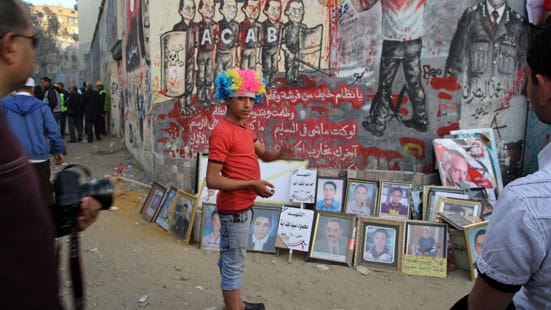
Ronnie Close, Street protest against President Morsi, Tahrir Sq Nov 2012. (wigs and masks are popular).
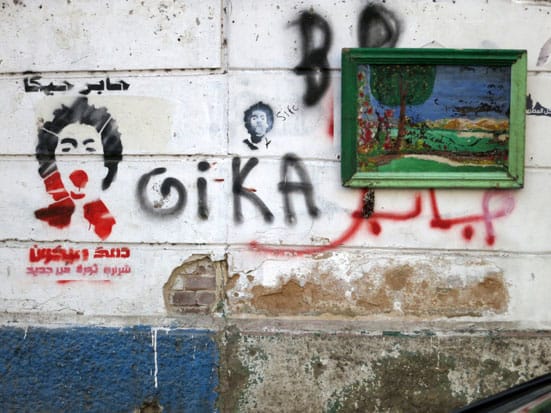
Ronnie Close, Stencil for April 6th murdered member, Giko, 17 years old, Tahrir Sq Nov 2012. (don't know what the painting is doing there)
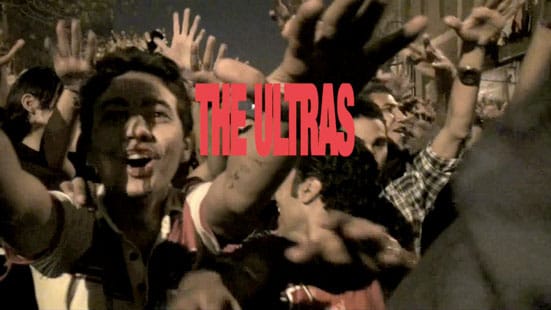
Ronnie Close, Ultras film still, 2012.
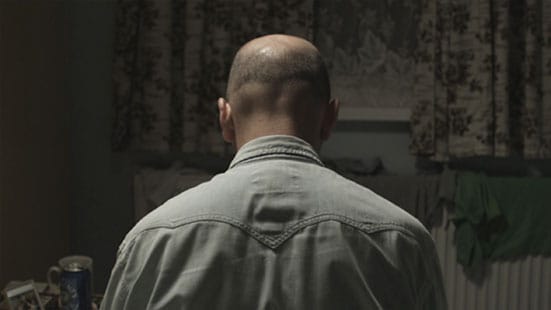
Ronnie Close, Night Time Room film still, 2009.
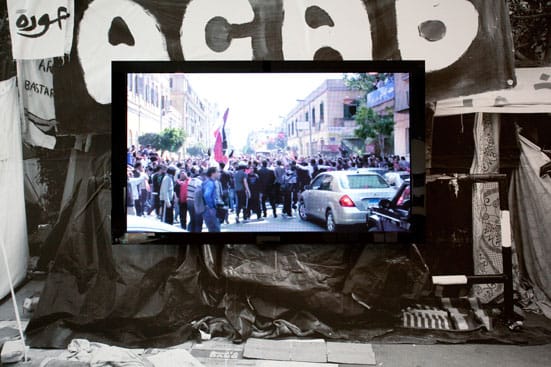
Ronnie Close, Brighton Photo Biennial exhibition Install photo for Ultras work, Oct 2012.